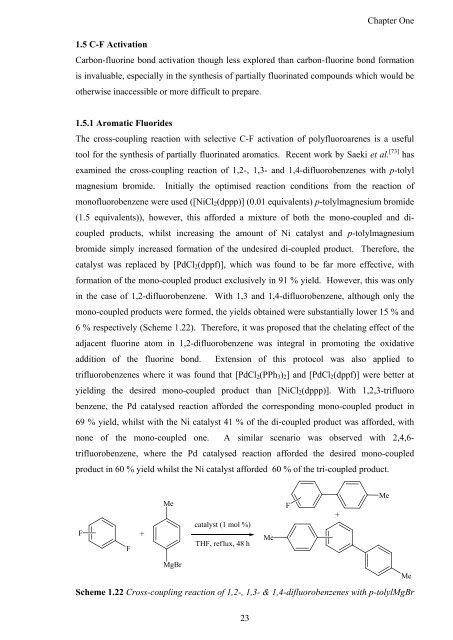Synthesis and Comparison of the Reactivity of Allyl Fluorides and ...
Synthesis and Comparison of the Reactivity of Allyl Fluorides and ...
Synthesis and Comparison of the Reactivity of Allyl Fluorides and ...
You also want an ePaper? Increase the reach of your titles
YUMPU automatically turns print PDFs into web optimized ePapers that Google loves.
1.5 C-F Activation<br />
23<br />
Chapter One<br />
Carbon-fluorine bond activation though less explored than carbon-fluorine bond formation<br />
is invaluable, especially in <strong>the</strong> syn<strong>the</strong>sis <strong>of</strong> partially fluorinated compounds which would be<br />
o<strong>the</strong>rwise inaccessible or more difficult to prepare.<br />
1.5.1 Aromatic <strong>Fluorides</strong><br />
The cross-coupling reaction with selective C-F activation <strong>of</strong> polyfluoroarenes is a useful<br />
tool for <strong>the</strong> syn<strong>the</strong>sis <strong>of</strong> partially fluorinated aromatics. Recent work by Saeki et al. [73] has<br />
examined <strong>the</strong> cross-coupling reaction <strong>of</strong> 1,2-, 1,3- <strong>and</strong> 1,4-difluorobenzenes with p-tolyl<br />
magnesium bromide. Initially <strong>the</strong> optimised reaction conditions from <strong>the</strong> reaction <strong>of</strong><br />
mon<strong>of</strong>luorobenzene were used ([NiCl2(dppp)] (0.01 equivalents) p-tolylmagnesium bromide<br />
(1.5 equivalents)), however, this afforded a mixture <strong>of</strong> both <strong>the</strong> mono-coupled <strong>and</strong> di-<br />
coupled products, whilst increasing <strong>the</strong> amount <strong>of</strong> Ni catalyst <strong>and</strong> p-tolylmagnesium<br />
bromide simply increased formation <strong>of</strong> <strong>the</strong> undesired di-coupled product. Therefore, <strong>the</strong><br />
catalyst was replaced by [PdCl2(dppf)], which was found to be far more effective, with<br />
formation <strong>of</strong> <strong>the</strong> mono-coupled product exclusively in 91 % yield. However, this was only<br />
in <strong>the</strong> case <strong>of</strong> 1,2-difluorobenzene. With 1,3 <strong>and</strong> 1,4-difluorobenzene, although only <strong>the</strong><br />
mono-coupled products were formed, <strong>the</strong> yields obtained were substantially lower 15 % <strong>and</strong><br />
6 % respectively (Scheme 1.22). Therefore, it was proposed that <strong>the</strong> chelating effect <strong>of</strong> <strong>the</strong><br />
adjacent fluorine atom in 1,2-difluorobenzene was integral in promoting <strong>the</strong> oxidative<br />
addition <strong>of</strong> <strong>the</strong> fluorine bond. Extension <strong>of</strong> this protocol was also applied to<br />
trifluorobenzenes where it was found that [PdCl2(PPh3)2] <strong>and</strong> [PdCl2(dppf)] were better at<br />
yielding <strong>the</strong> desired mono-coupled product than [NiCl2(dppp)]. With 1,2,3-trifluoro<br />
benzene, <strong>the</strong> Pd catalysed reaction afforded <strong>the</strong> corresponding mono-coupled product in<br />
69 % yield, whilst with <strong>the</strong> Ni catalyst 41 % <strong>of</strong> <strong>the</strong> di-coupled product was afforded, with<br />
none <strong>of</strong> <strong>the</strong> mono-coupled one. A similar scenario was observed with 2,4,6-<br />
trifluorobenzene, where <strong>the</strong> Pd catalysed reaction afforded <strong>the</strong> desired mono-coupled<br />
product in 60 % yield whilst <strong>the</strong> Ni catalyst afforded 60 % <strong>of</strong> <strong>the</strong> tri-coupled product.<br />
Scheme 1.22 Cross-coupling reaction <strong>of</strong> 1,2-, 1,3- & 1,4-difluorobenzenes with p-tolylMgBr














